A simpler life begins at home – key tips from people who've done it
- Written by Marisa McArthur, PhD Candidate, School of Technology Environments and Design, University of Tasmania
Voluntary simplicity focuses on doing more with less. People who choose this way of life seek other riches, like personal fulfilment, free time, community and environmental benefits. They see limiting their consumption as a way to improve their quality of life and flourish.
We wanted to learn about people who choose this path. What lessons do they have to share? In particular, how can housing be designed to support simplicity?
Read more: How 'Earthships' could make rebuilding safer in bushfire zones
We talked in depth to 14 householders and 25 housing industry professionals. As well as the householders, 11 of the professionals had made housing changes to simplify their own lives. Our conversations focused on life stories and beliefs, thoughts on voluntary simplicity, and ways to overcome the challenges they faced.
Our recently published research shows it is possible, with a bit of work and planning, to live a simple and fulfilling life. We focused on housing, because housing choices are at the heart of such a life. Our social connections, incomes, transport needs and energy and water usage all link to where and how we live.
Despite continuing increases, house and land prices are lower in Tasmania than on mainland Australia, but so are incomes. Just as elsewhere, housing practices here can lock householders into complicated consumption practices with negative consequences for society and the environment. Needing to work more to pay off bigger mortgages is one aspect of this.
Read more: People want and need more housing choice. It's about time governments stood up to deliver it
Compromises are inevitable
Some participants wanted housing that encompassed environmental best practice and closeness to nature. Some wanted to connect with like-minded people. Some wanted smaller or no mortgages.
But “you can’t have it all”, we were told. Compromises are inherent in striving for voluntary simplicity in housing.
For example, you might want an off-grid eco-haven, but that’s unlikely in the inner city. You might need public transport, but that could rule out retrofitting a bush block home.
The ethically sourced building materials you select from interstate or overseas might involve supply chains using multiple transport modes and all the fossil fuel these use. Locally sourced materials might not meet your ethical standards. And are you happy to buy your solar panels using credit from a Big Four bank that invests in fossil fuels?
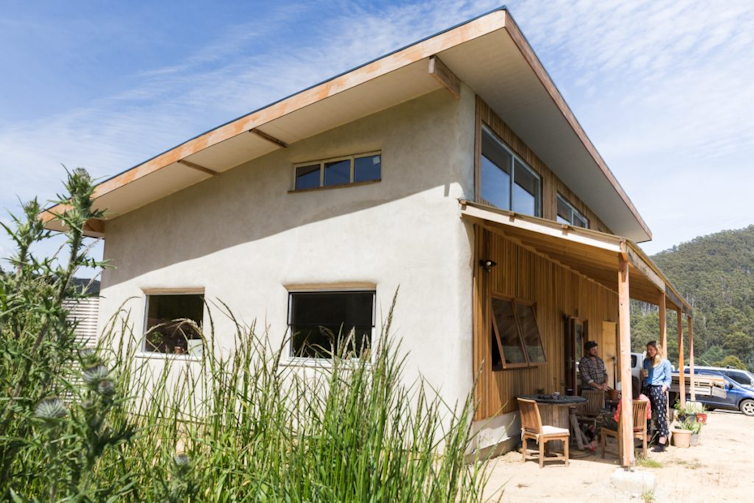 Many people in our study built homes from natural or recycled materials, like straw bales (shown here), rammed earth and repurposed timber, because of their natural aesthetic and lower environmental impact.
Used with permission of Natalie Mendham/Designful, Author provided (No reuse)
Many people in our study built homes from natural or recycled materials, like straw bales (shown here), rammed earth and repurposed timber, because of their natural aesthetic and lower environmental impact.
Used with permission of Natalie Mendham/Designful, Author provided (No reuse)
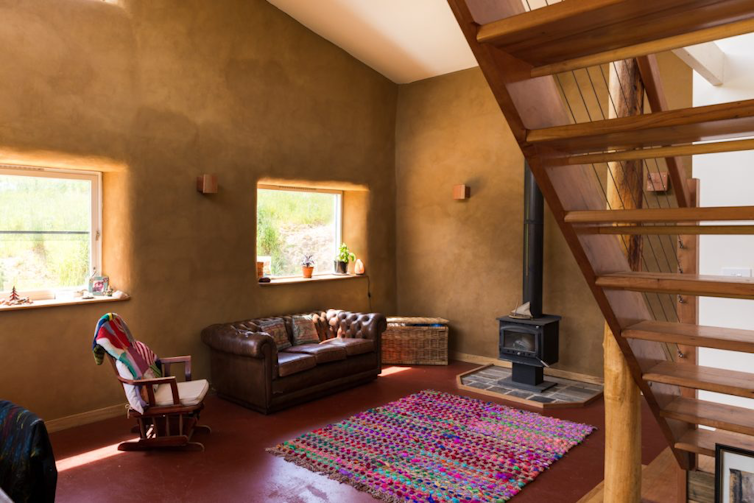 Cosy lounge and kitchen spaces were important to people who value social connection and spending time at home.
Used with permission of Natalie Mendham/Designful, Author provided (No reuse)
Cosy lounge and kitchen spaces were important to people who value social connection and spending time at home.
Used with permission of Natalie Mendham/Designful, Author provided (No reuse)
So, know your deal-breakers and accept that you cannot be “a model of simplicity” in every way all the time. “Do what you can for the context you’re in.”
A resounding piece of advice from the professionals was “smaller is better”.
Read more: So, you want to live tiny? Here's what to consider when choosing a house, van or caravan
Do your homework
To find palatable compromises you must do your homework. For example, many people wanted to save money or have meaningful experiences of creating house and home.
That level of engagement takes a lot of work, which surprised several participants. It requires project-management skills and familiarity with regulations beforehand.
You might need specialist professionals on board from the start. A building designer told us:
You’re doing something different from the norm, so your standard industry professional might not be experienced with the regulations for composting toilets, on-site greywater systems, or even smaller-than-average houses.
Situations might change mid-project. Participants emphasised how important it is to be prepared for regulatory reforms, technological change and unexpected costs. Communication is crucial – with family, professionals and tradespeople, councils and suppliers.
One owner-builder told us:
It’s like a little treasure hunt. Ask lots of questions but gather them all together because professionals charge per hour or part thereof. Find people who have experience with a similar build or project. We asked friends for basic info, then asked the experts once we had some background.
Options and requirements might not be obvious. Finding professionals with similar values who have a talent for project administration, regulations and time management can be hugely helpful. Another building designer told us:
It’s becoming increasingly hard to build a home without professional help. If you don’t know the order in which to do things, and how one influences the other, it can become very stressful and costly and time-consuming.
Confidence and patience are useful attributes. Another owner-builder said:
You’ll be talking with people who know their stuff (or think they do) and are used to working with other professionals. It’s hard to call someone about a product not knowing what you’re talking about, but do it anyway and don’t be scared. At the end of the day, we were responsible for every aspect of our place, so why not take control? It gets easier once you start doing it.
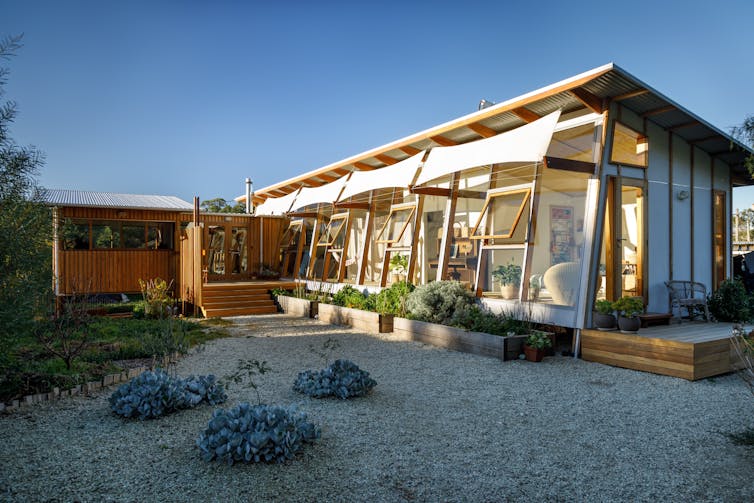 Householders and experts favoured homes designed with small footprints and passive solar principles for their simplicity and environmental performance.
Used with permission of Peter Mathew/Beachouse Architecture, Author provided (No reuse)
Householders and experts favoured homes designed with small footprints and passive solar principles for their simplicity and environmental performance.
Used with permission of Peter Mathew/Beachouse Architecture, Author provided (No reuse)
Be patient and know your limitations
Since everything seems to “take so much longer than planned”, remember you are there for the long haul.
If you want to move faster, you often have to pay experts for the privilege. As one owner-builder said: “We could have gotten away without the loan if time weren’t a factor.”
The more you do yourself as a non-expert the more you learn. But even if you are careful, you might make mistakes that cost time and money. So “be guided by your emotions and values but don’t let them get the best of you”.
 This owner-built straw bale home is a product of creativity, commitment and years of hard work. The owners wanted to be close to nature, grow some of their own food, keep animals and have composting and greywater systems.
Author provided
This owner-built straw bale home is a product of creativity, commitment and years of hard work. The owners wanted to be close to nature, grow some of their own food, keep animals and have composting and greywater systems.
Author provided
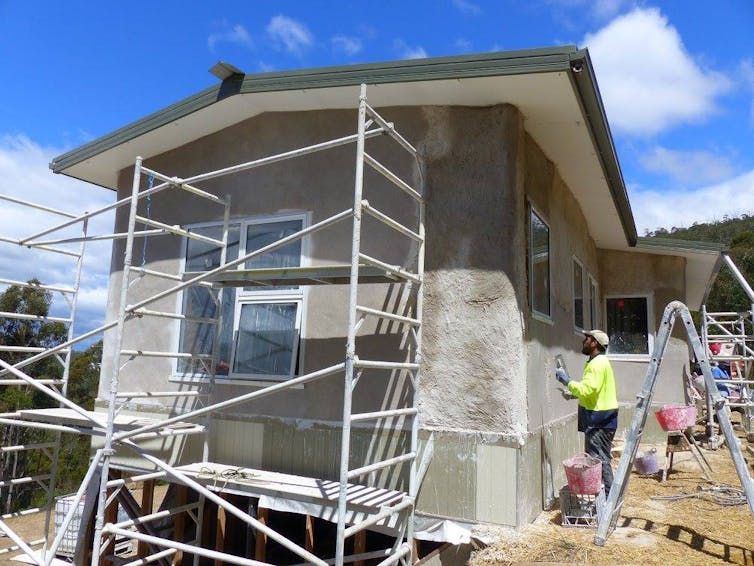 A work in progress: rendering the straw bales involved input from professional renderers, family and friends.
OzEarth/Facebook
A work in progress: rendering the straw bales involved input from professional renderers, family and friends.
OzEarth/Facebook
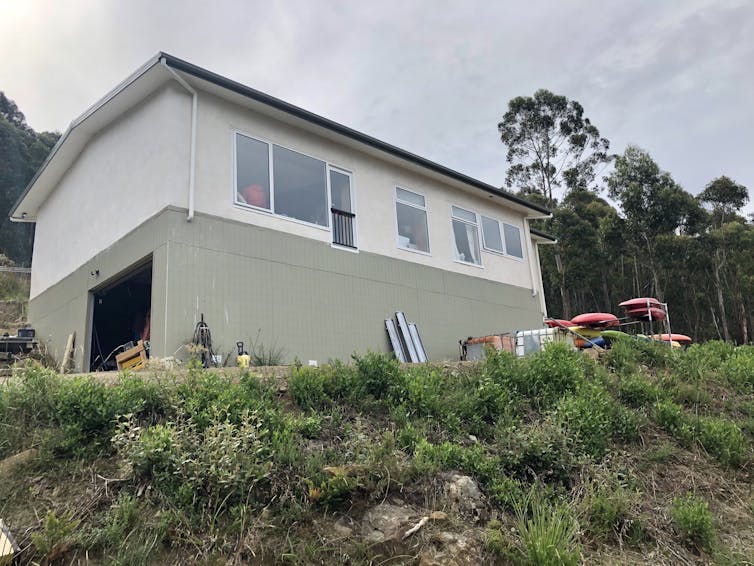 Living closer to the bush can mean more space for things like outdoor sporting equipment and sheds or garages, which some householders valued for self-sufficiency and connection to nature.
Author provided
Living closer to the bush can mean more space for things like outdoor sporting equipment and sheds or garages, which some householders valued for self-sufficiency and connection to nature.
Author provided
The project of a lifetime
The voluntary simplicity housing journey also affects professionals. One building designer told us:
I hope to see myself as an interpreter of what people want. It might be the project of a lifetime for someone who has spent their life savings on it, so I feel a responsibility to provide some sort of pastoral care. For owner-builders, the house becomes a part of the family in some ways.
That means being friendly, patient, communicative and paying attention to how clients experience the whole system from planning regulations to the philosophies of sustainability.
In practice, simple living is a huge journey. But with thought, planning and hard work, it can be extremely satisfying and rewarding.
Committing to voluntary simplicity in housing (or anything else) is never a complete response. But, as part of a suite of positive responses to contemporary challenges, from climate change to community cohesion, it’s worth working for as individuals and as professionals.
Read more: Bamboo architecture: Bali's Green School inspires a global renaissance
Authors: Marisa McArthur, PhD Candidate, School of Technology Environments and Design, University of Tasmania
Read more https://theconversation.com/a-simpler-life-begins-at-home-key-tips-from-people-whove-done-it-132081



